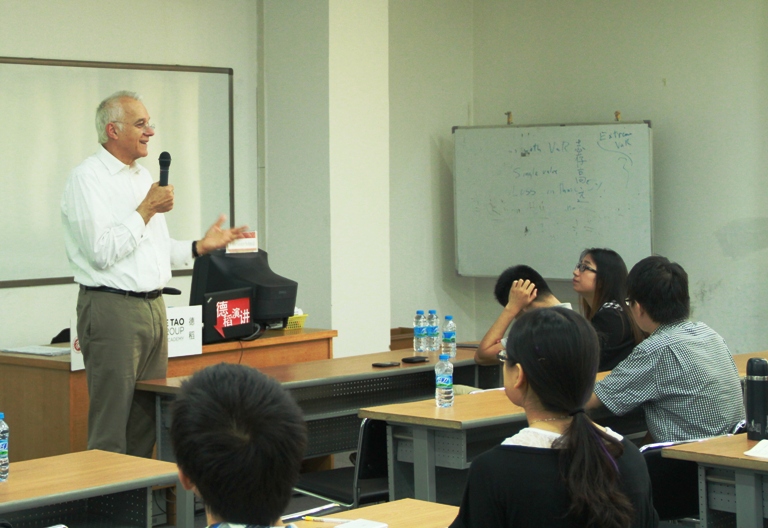
Cities have evolved in the past decades. In China and around the world, rapid development has taken over other aspects of life and people have forgotten what is really important: the prosperity of their lives. Quality of life is important and the city, which represents the place where we live and work, is a major part of it. As a result, it is vital to take care of our city, build it to meet new, efficient and sustainable characteristics.
Professor J. Alexander Schmidt, who visited our campus on October 30th to talk about how the cities of tomorrow should look, studied architecture and city planning at the University of Stuttgart. In 1978, he graduated from the University of California Berkeley and received his Ph.D. from the University Stuttgart in 1989. In recent years, he has been the Head of the Institute of City Planning and Urban Design and has over 25 years professional experience in the fields of city planning and urban design
Professor Schmidt started his presentation by stating that cities and urbanization have peaked in the past thirty years, as integrated urban planning concepts were ruled by cars. This last is the reason why planners, people and political leaders are all saying “Please save the city.” The goal is to create a sustainable low carbon eco city, not only by urban planning and designing, but also by integrating other important aspects such as: health, ecology, economy, nature, ecology culture and mobility.
The presentation then focused on the development of Chinese cities. He mentioned in his allocation that people should focus on the quality of life and key components for urban development. It is urgent to tackle problems such as the destruction of natural environment, reduction of arable areas and climate change. Sustainable development is urgently needed. Urban development and economic growth have created new towns all over China, with many success stories as migrants from rural districts come seeking new opportunities, which resulted into redeveloping cities, wealth and rising standard of living.
On the other hand, these population movements are the source of many challenges such as unlimited urban growth, missing integrated concepts, high consumption of land resources and cities without urbanity. City officials have no choice but to focus on speed of construction, with no identity and not enough efforts for quality.
Professor Schmidt sees the city as an opportunity to showcase the culture, education, economy and image of its people. For him, “if the city did not exist, we would invest it.” At the same time, the city is a challenge that demands a lot of work, high consumption of resources and high energy.
Today, the dilemma is: Can we construct cities where we love to live, have a good quality of life and enjoy our environment? Or are we just victims of rapid development? The answer is yes, we can do all the above, but we always have to keep in mind that a city is not just about employment, it is also about education, clean air and water, security and open space.
The cities of today have been planned 10 years ago. We have to change our mindsets to plan for the cities of today and tomorrow. Professor Schmidt emphasized the responsibility of urban planners as they play a major role in this matter. “We need time and knowledge, urbanization in China was very rapid and only took 15 years, compared to 50 years in Europe and other parts of the world, he mentioned.”
What we need to do for the future is to change the city from a car oriented to a people friendly one. This task will take a lot of time, maybe 2 to 3 decades. New ways of transportation have to be created and technology, especially Smart phones, will help us in this transition.
Professor Schmidt concluded by stating that a healthy city is a city which has large open spaces, public space vegetation, public parks, “walkability” and “bike-ability” for better health of its population. A city needs to be functional and beautiful. Basing the design of the city on the economy is not the right way to go. Education is very important in raising awareness and schools have a large responsibility in this matter. The time to act is now.
Written by Hicham Lefnaoui